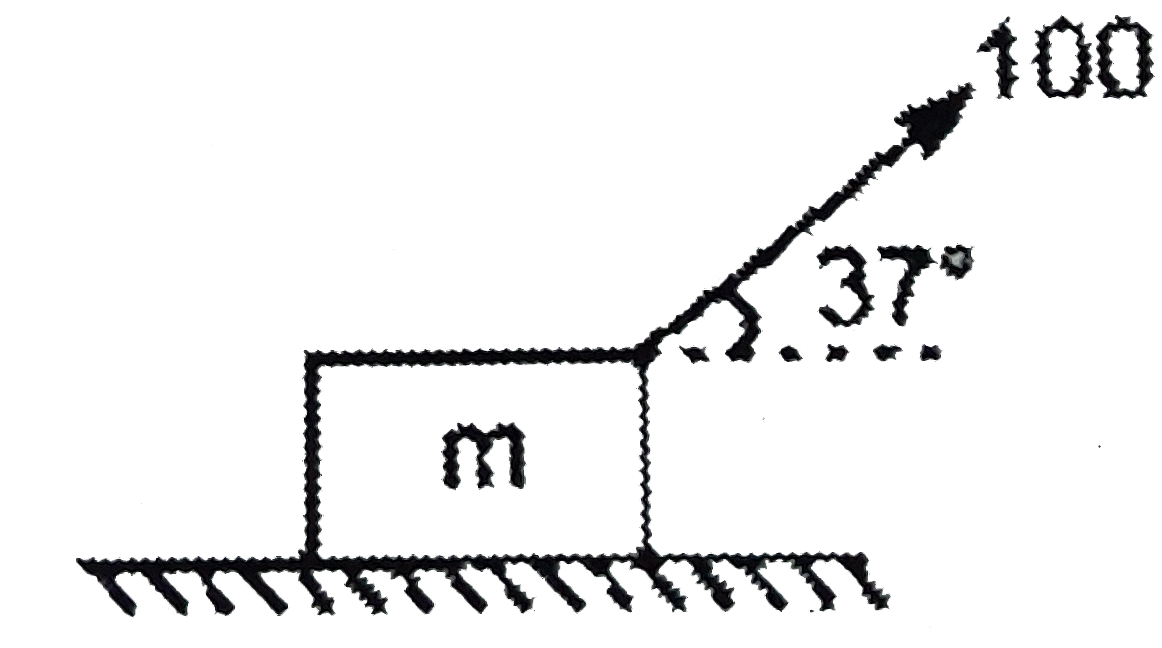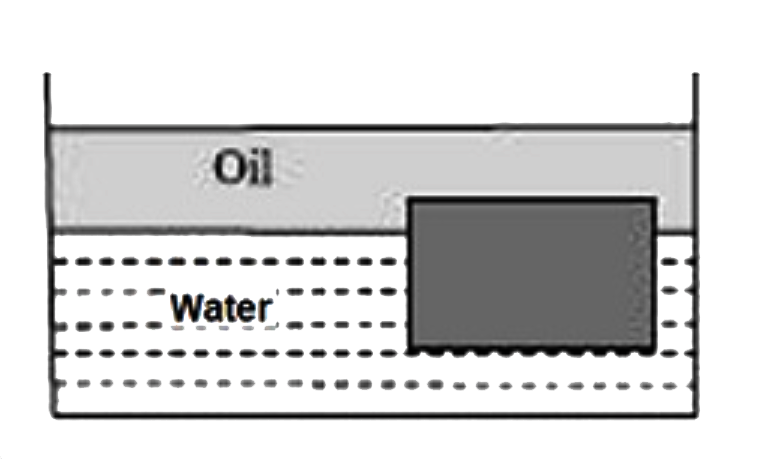A block of mass 5 kg and volume 0.05m3 floats in a liquid of density 140kg m−3 .
The fraction of block inside liquid is
75
27
57
72
The correct Answer is:C
To find the fraction of the block that is submerged in the liquid, we can follow these steps:
Step 1: Understand the Problem
We have a block of mass m=5kg and volume V=0.05m3 floating in a liquid with a density ρL=140kg/m3. We need to find the fraction of the block's volume that is submerged in the liquid.
Step 2: Use Archimedes' Principle
According to Archimedes' principle, the weight of the liquid displaced by the submerged part of the block is equal to the weight of the block itself when it is floating.
Step 3: Set Up the Equation
Let V0 be the volume of the block that is submerged in the liquid. The weight of the block is given by:
Weight of the block=m⋅g
where g is the acceleration due to gravity (approximately 9.81m/s2).
The weight of the liquid displaced by the submerged volume V0 is:
Weight of displaced liquid=V0⋅ρL⋅g
Setting these two weights equal gives us:
m⋅g=V0⋅ρL⋅g
Step 4: Cancel g from Both Sides
Since g is present on both sides, we can cancel it out:
m=V0⋅ρL
Step 5: Solve for V0
Rearranging the equation to solve for V0:
V0=mρL
Step 6: Substitute the Values
Now, substituting the known values:
V0=5kg140kg/m3=5140m3=128m3
Step 7: Find the Fraction of the Block Submerged
The fraction of the block submerged F is given by:
F=V0V
Substituting the values we have:
F=1280.05
Step 8: Calculate the Fraction
To simplify F:
F=128÷0.05=128×10.05=128×20=2028=57
Final Answer
The fraction of the block that is submerged in the liquid is:
57
---
We have a block of mass m=5kg and volume V=0.05m3 floating in a liquid with a density ρL=140kg/m3. We need to find the fraction of the block's volume that is submerged in the liquid.
According to Archimedes' principle, the weight of the liquid displaced by the submerged part of the block is equal to the weight of the block itself when it is floating.
Let V0 be the volume of the block that is submerged in the liquid. The weight of the block is given by:
Weight of the block=m⋅g
where g is the acceleration due to gravity (approximately 9.81m/s2).
Weight of displaced liquid=V0⋅ρL⋅g
m⋅g=V0⋅ρL⋅g
Since g is present on both sides, we can cancel it out:
m=V0⋅ρL
Rearranging the equation to solve for V0:
V0=mρL
Now, substituting the known values:
V0=5kg140kg/m3=5140m3=128m3
The fraction of the block submerged F is given by:
F=V0V
Substituting the values we have:
F=1280.05
To simplify F:
F=128÷0.05=128×10.05=128×20=2028=57
The fraction of the block that is submerged in the liquid is:
57
Topper's Solved these Questions
- BOOK - MTG IIT JEE FOUNDATIONCHAPTER - THRUST AND PRESSUREEXERCISE - Exercise (Subjective problem (Very short answer type) )15videos
THRUST AND PRESSURE
- BOOK - MTG IIT JEE FOUNDATIONCHAPTER - THRUST AND PRESSUREEXERCISE - Exercise (Subjective problem (Short answer type) )15videos
THRUST AND PRESSURE
- BOOK - MTG IIT JEE FOUNDATIONCHAPTER - THRUST AND PRESSUREEXERCISE - Exercise (Assertion & Reason type)10videos
THRUST AND PRESSURE
- BOOK - MTG IIT JEE FOUNDATIONCHAPTER - SOUNDEXERCISE - Olympiad/HOTS Corner15videos
SOUND
- BOOK - MTG IIT JEE FOUNDATIONCHAPTER - WORK AND ENERGYEXERCISE - Olympaid/HOTS Corner20videos
WORK AND ENERGY
Similar Questions
A body of mass 2.0 kg and density 8000 kgm3 is completely dipped in a liquid of density 800 kgm3. Find the force of buoyancy on it.
View SolutionIn Fig. , a rectangular block floats in a liquid . A block of mass m = 0.500 kg and density ρ=700kg/m3 floats face down in a liquid of density ρf=1200kg/m3 . What are the magnitude of the buoyant force on the block from the liquid , the weight of the liquid displaced by the block (liquid that would be in the space now occupied by the block ) , and the mass of that displaced liquid ? What fraction of the block's volume is submerged ? What fraction of its height is submerged ?
 View Solution
View Solution
Knowledge Check
- Question 1 - Select One
A block of mass 5 kg and volume 0.05m3 floats in a liquid of density 140kg m−3 .
Fraction of block outside liquid isA27B72C37D73 - Question 2 - Select One
A block of mass 5 kg and volume 0.05m3 floats in a liquid of density 140kg m−3 .
Volume of block above the surface of liquid isA0.024m3B0.014m3C0.015m3D0.041m3 - Question 3 - Select One
A cylindrical of wood (density =600kgm−3) of base area 30cm2 and height 54cm, floats in a liquid of density 900kg−3 The block is deapressed slightly and then released. The time period of the resulting oscillations of the block would be equal to that of a simple pendulum of length (nearly) :
A26cmB52cmC36cmD65cm
m=20kg,μs=0.5, find friction on block.
 View Solution
View SolutionA body of mass 2.0 kg and density 8000 kgm3 is completely dipped in a liquid of density 800 kgm3. Find the force of buoyancy on it.
View SolutionA cubical block 'A' of mass m0(=a3ρ=3kg) of edge 'a' and density ρ floats in a liquid of density 3ρ. The lower surface of the cube just touches the free end of massless spring of spring of spring constant k(=a2ρg) fixed at the bottom of the vessel. Another block 'B' of mass 'm' is lept over block 'A', so that is completely immersed in liquid without wetting the block 'B'. Then find the value of m in kg.
View SolutionA wooden block of density 860kg/m3 at 0∘C is floating on bezene liquid of density 900kgm3 at 0∘C. The temperature at which the block just submerge in benzene is
[γwood=8×10−5/∘c,γbenzene=12×10−4/∘c]View SolutionA layer of oil with density 724 kg m−3 floats on water of density 1000kgm−3. A block floats on the oil-water interface with 1/6 of its volume in oil and 5/6 of its volume in water, as shown in the figure. What is the density of the block?
 View Solution
View Solution

